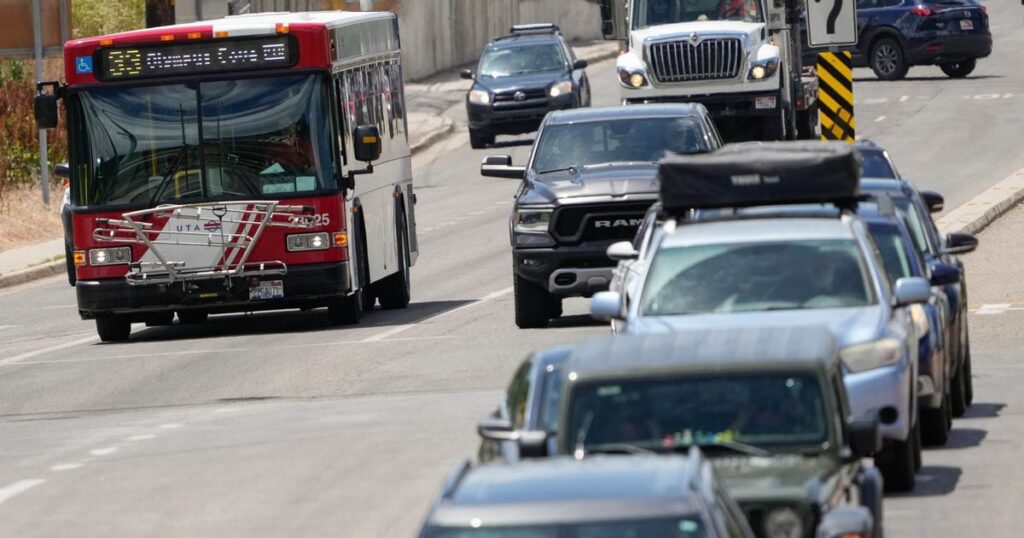Discover the most compelling reason to start taking the bus: a system that cuts your commute time.
(Francisco Kyorses | The Salt Lake City Tribune) A UTA bus travels through the streets of Salt Lake City on Friday, June 21, 2024.
| June 22, 2024 12:00 pm
| Updated: 4:38 PM
Having green lights all through your commute may seem like something out of the movie “The Italian Job,” but thanks to a huge injection of federal funding, Salt Lake City transit riders will soon be able to speed to their destinations.
Utah is one of three states selected by the U.S. Department of Transportation’s Federal Highway Administration to deploy vehicle-to-everything (V2X) technology. A $20 million federal grant will allow the Utah Department of Transportation to improve intersections and install sensors that send information to approaching vehicles.
The federal government says the technology can alert cars to weather events, collisions and even pedestrians, giving drivers time to adjust before an obstacle comes into view and slows down.
In addition, signal priority will make commuting by bus faster.
Utah Transportation Agency’s fleet of 87 buses is already equipped with V2X capabilities that allow buses to delay traffic by a few seconds when the light is green, Commissioner Jay Fox said at a press conference Thursday, adding that UTA’s entire fleet is expected to be equipped with the technology within the next five years.
UDOT’s snowplows are also equipped with V2X technology, which helps operators clear roads faster and warns drivers about snow removal zones, said Executive Director Carlos Braceras, who expects the technology will make a big difference in the way people drive.
(Jordan Miller | The Salt Lake City Tribune) Utah Department of Transportation Commissioner Carlos Braceras speaks during a news conference Thursday, June 20, 2024, in Salt Lake City.
“Since seat belt use became mandatory, our country has seen a decline in serious injuries and fatalities. [automatic braking systems] “Once it’s deployed, you’ll actually see what the impact is, just like when an airbag deploys,” Braceras says. “I think we’ll look back in a few years on mass adoption of V2X and go, ‘Wow.'”
Federal highway administrator Shailen Bhatt said Thursday’s announcement is part of a larger plan to make the technology more widely available. Bhatt said automakers need to recognize the need to deploy V2X technology at scale, “because that’s the only way you’re going to actually get connectivity.”
(Jordan Miller | The Salt Lake City Tribune) Utah Department of Transportation technical engineer Blaine Leonard demonstrates how V2X technology is integrated into traffic signals, Thursday, June 20, 2024, at the intersection of 2100 East and Foothill Drive.
Utah already has the nation’s first “connected” vehicle corridor along Redwood Road, where UTA buses equipped with special radios already communicate with traffic signals, making the state a pioneer of V2X systems.
About 20 percent of traffic signals in Salt Lake City are equipped with the technology, including those at Foothill Drive and 2100 East, where UDOT officials demonstrated traffic signal prioritization during a press conference Thursday. UDOT said it plans to roll out the technology to up to 25 percent of the city’s signals in the coming months.
Mayor Erin Mendenhall praised the investment.
“The clock will tell you when your exercise ring is about to close. It will tell you to get outside and start moving. It will tell you when you’ve been sitting too much and need to stand up,” she said. “Imagine that… bridges, roads, traffic lights, the car ahead alerting your vehicle and you to dangers and letting you know you need to change your behavior. … It’s a huge advantage for Utah, and several other states, to be at the forefront of this investment with our federal partners.”

